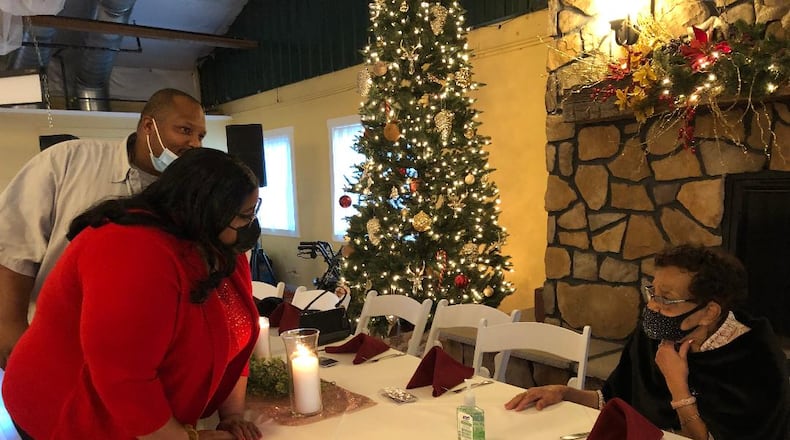I lost count.
The second yielded a total of 190 steps of my 6-foot-2-inch frame.
Tuesday, I asked Marshall her height to calibrate and get a better sense of what it takes for a 102-year-old — who’s 14 inches shorter and three decades older — to cover that distance on the commute for two meals in the first-floor dining room.
As it turned out, the answer to my question also answers the question of why Lagonda Chapter Daughters of the American Revolution honored Mrs. Marshall that day with its first ever Community Service Award.
What both take is this: The persistence to keep on being yourself, which Mrs. Marshall got busy doing again on Wednesday when she turned 103.
Both humble and celebrated
News-Sun readers of recent years know the essentials of Marshall’s story from the Dec. 7, 2021 profile my colleague Brett Turner wrote just after Marshall celebrated her 100th birthday.
I write about her again today to take the measure of the challenges she faces, and I’ve seen my 96-year-old mother face in recent years, while following her walker through the obstacle course of older age.
While she often has told me that “it’s not for sissies,” her forbearance of the injections into the eye meant to slow the progression of her macular degeneration seem tantamount to keeping a cool head while facing an obstacle that would send American Ninja Warrior contestants plummeting into the waters below.
Like Mrs. Marshall, my mother lives in a wonderful apartment in a retirement home, goes to the exercise classes it offers three days a week and watches what she eats. While Mrs. Marshall has given up bowling for cornhole, my mother continues to intimidate others at the bridge table — and like Mrs. Marshall — attend on-site programs, manage her own schedule, and cultivate needed friendships in a setting in which friends disappear on a regular basis.
These similarities between our mothers convinced me I’d feel the sense of kinship I did when meeting her sons, Reggie and Mike.
Indeed, the lone difference seems to be that that while her younger son, Mike, lives nearby and his brother, Reggie, out of state, my older brother, Bill is the one who lives near our mom and I make the trip for visits.
Like me, Reggie is grateful to his brother for shouldering the responsibilities of continuous support. Both my Bill and his Mike make multiple visits each week and respond to medical emergencies and trips to the drug store.
What all four of us feel is a sense of our mothers as people still very much engaged in life, a habit that makes them engaging people.
“I think the friendship and getting to know her better and experiencing the times together has meant a lot to me,” Mike said. “She just amazes me with the stuff she’s able to remember at her age and things she’s able to do by herself and stay by herself.”
Just as Reggie takes great pride in the advances his mother has made in texting in the past six months, I found myself overjoyed when, after thanking the receptionist for asking if my mom was alright the morning after a fall, the young woman spoke words I had never imaging hearing about my mom: “She’s my girl.”
In the most mind-altered state of my youth, I never thought there would be any person I’d look forward to taking to Wal-Mart to shop for underwear and still want to spend more quality time with over a fish sandwich at Culver’s.
Community service
The community service for which Mrs. Marshall is being recognized involves serving communion and occasionally reading the liturgy at Sunday services held at Oakwood Village by her home church, Covenant Presbyterian.
Jody Noble describes Alice and others as the glue of the congregation of 20 or so that gathers regularly. In a setting in which mobility can’t be assumed, people including Alice “just decide they’re going to take advantage of the possibilities of mobility” – and personal purpose – in doing what they’ve done for so long: Serving the community in which they live.
In the face of the challenges they grapple, they bring “a determination that if life knocks you down 12, you get up 13. They just decide to go (and keep going).
“And it’s not just for them,” she adds, “it’s for other people.”
“Even when (Alice’s) her heart is heavy, she names the heaviness, and then the smile returns and she says, ‘but I know the Lord will get me through it somehow.’ And then she stands on his promises on her own two feet.”
Noble’s next words reminded me of my own mother’s including on her daily to-do list plans to look in on a friend who has lost a husband or had a surgery or another whose family is in turmoil.
Noble sees in that kind of behavior our free will at work.
“When age has taken its toll, you can grow cynical,” she said, “but you can always pick up a phone, you can always give a person a smile.”
People who do, she said, “are the people who can inspire others and give you hope. Alice is a master at that, and she does it so gently and so kindly.”
Which makes guys like Mike, Reggie, Bill me – and some of you readers out there, too – proud of our older mothers and fathers who, behind their walkers, continue to teach us how to behave when we grow up.
About the Author
